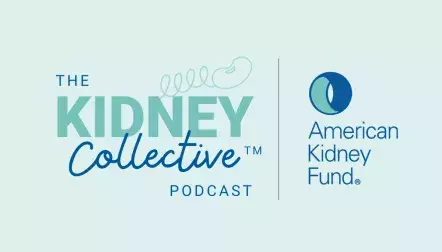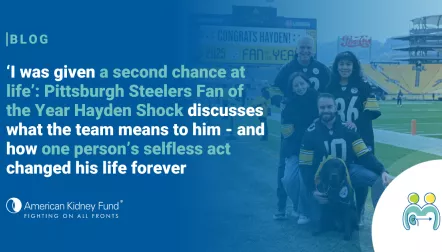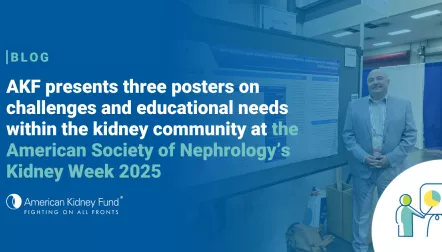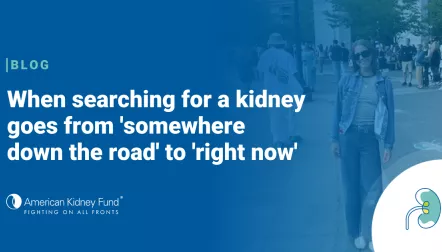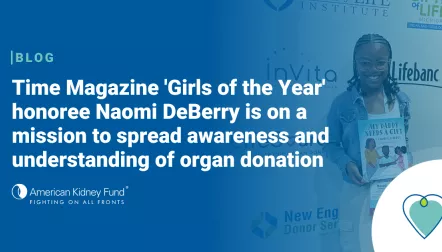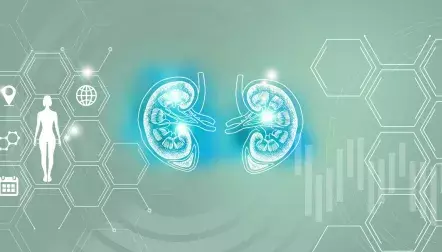
Blog post
A voucher for a kidney: Is the transplant voucher program right for you?
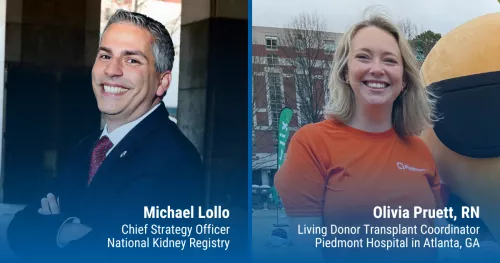
The American Kidney Fund (AKF) talked with Michael Lollo, the chief strategy officer from the National Kidney Registry (NKR), and Olivia Pruett, a living donor transplant coordinator and RN at Piedmont Hospital in Atlanta, to discuss the benefits of one of the lesser-known transplant options available to kidney patients: the transplant voucher program.
Like any voucher program, the transplant voucher program allows you to exchange a voucher for an item. In this case, that "item" is a kidney. Vouchers are given to living kidney donors who participate in this NKR-run program. The donor may not be a match for the person they want to donate to or they may be donating to a stranger.
In either case, the donor donates their kidney and receives a voucher that someone of their choosing can then use to receive a kidney. Then, both the donor and the voucher holder receive priority status on NKR's transplant wait list if or when they need a kidney. Vouchers also never expire: "They're in existence for as long as the NKR is in existence," Michael said.
There are two types of vouchers available: the standard and the family voucher. The standard voucher gives one voucher to a person the donor knows who needs a kidney "imminently" — usually within the next 12 months. The family voucher allows the donor to name multiple people (typically up to five names, but Michael said NKR is often flexible with this limit) who could someday use the voucher.
"We also don't define 'family,'" Michael said. "So, you could name your mailman, technically, as far as the NKR is concerned."
Here are some other reasons you may want to consider using the transplant voucher program to donate a kidney:
Shorten the recipient's wait time for a kidney
Regardless of whether the transplant is done through the transplant voucher program or another transplant program, receiving an organ from a living donor reduces wait times. There are more than 90,000 people waiting for a kidney in the U.S. right now, and unfortunately, wait times for a deceased kidney can be years. "You drastically shorten your wait time by many, many, many, many years – you could cut your wait time down to months if you're able to find a living donor," said Michael. "So, a living donor affords a patient the ability to be transplanted a lot sooner than waiting on the deceased donor wait list."
Get living donor prioritization
Many potential living donors worry that they may need a kidney someday. Donors can have this worry eased when they donate with the voucher program.
"One of the biggest benefits with donating through the National Kidney Registry, however you donate, is that you get prioritization for the living donor pool," said Olivia. "So, if I donated and I was a voucher donor and I ever needed a kidney in the future, I automatically get priority regardless if a voucher has ever been redeemed. Which is nice because donors get priority on the UNOS wait list, currently, the way the laws are, but [they are not guaranteed priority] for a living donor necessarily. So, they would have to go through the whole search of finding a living donor, just like our recipients do. So, this kind of allows them to bypass that and be offered a living donor."
Get the benefits of receiving a kidney from a living donor
If a recipient gets a kidney from a living donor, they often have better post-transplant outcomes, including less chance of rejection and the kidney lasting longer. Living donor transplants last 15 to 20 years on average, compared to 10 to 15 years on average for deceased donor transplants.
Donate on your timeline
With the voucher program, a donor can donate their kidney before the person they want to name for a voucher needs a kidney. "Say, a mom wants to donate because she knows her 10-year-old son is one day going to need a kidney," explained Olivia. "But by then she might be too old to donate to him directly. She can go ahead and donate, fill out a voucher for him and then when he gets to a point that he needs a transplant, he can then redeem his voucher."
This also means that a donor can choose the best timing for them to donate. An example Michael provided was, "I'm a schoolteacher. I want to donate in the summer. I don't want to donate during the school year. So, I could choose to do that. I can do my transplant July 1 and recover, and I'll be ready to go when September rolls around."
Split up donor and recipient surgery/recovery
If a donor and recipient undergo a traditional transplant surgery, they will be having surgery at the same time and recovering at the same time. The voucher program allows the surgeries — and recovery periods — to happen at different times, which may be more convenient for the pair. This can be a particularly appealing option when the donor is the primary caregiver for the recipient, or the donor and recipient would be caring for each other like spouses or roommates.
Possibly get a better match for the recipient
A donor may want to donate to someone with whom they are not a compatible match. Or perhaps they are a match, but not the best possible one. With the voucher program, they can still donate their kidney and the person they wanted to donate to will receive the voucher and get a better-matched kidney. As Olivia explained, "You could be a match for someone but there could be a closer match and with a closer match the kidney would last longer."
Olivia also pointed out that matching considerations not only include blood type and antibodies, but also size. "Say my kidneys are kind of small and I'm 30 years younger than you," she said. "Then I could go into the National Kidney Registry, and I can donate to someone who's younger. Or a child who can take a smaller kidney."
Altruistic donors can still help a loved one if they need a kidney later
"One of the disincentives [for people who want to donate to a stranger] is well, if my child ever needed a kidney or my wife ever needed a kidney, should I hold on to my kidneys?" said Michael. "Well, with the family voucher program, I can name all four: my wife and my three kids. And if, God forbid, they ever were to need a kidney, they have a voucher." With a voucher, that loved one would also be much higher on the transplant wait list.
Qualify for Donor Shield protection
Anyone who donates through NKR's transplant voucher program qualifies for their Donor Shield protections program, which provides financial, logistical and legal support to help protect living kidney and liver donors. Also, this benefit is available to any living donor who donates through NKR, not just people through the voucher program. "Recipient insurance will only cover a donor for a certain amount of time, depending on the insurance after surgery," explained Olivia. "And say, a donor ended up with an incisional hernia [a possible complication of transplant surgery] in three years, we would want them to not have to pay for that out of pocket. It is another surgery, so we'd be able to utilize Donor Shield to pay for that."
The program also includes lost wage coverage of $2,000 a week for up to six weeks (up to $12,000 total) and reimbursement for donation-related travel, lodging, meals or dependent care expenses (up to $5,000).
Also, Donor Shield complications protection does not have a time limit associated with it. If you experience any complication related to your kidney donation, you are eligible for Donor Shield coverage even years after your donation. While Donor Shield is a perk of the transplant voucher program, it is available to any living donor who donates through NKR.
Find out more about how to donate a kidney, how to find a living kidney donor or about the transplant voucher program.
